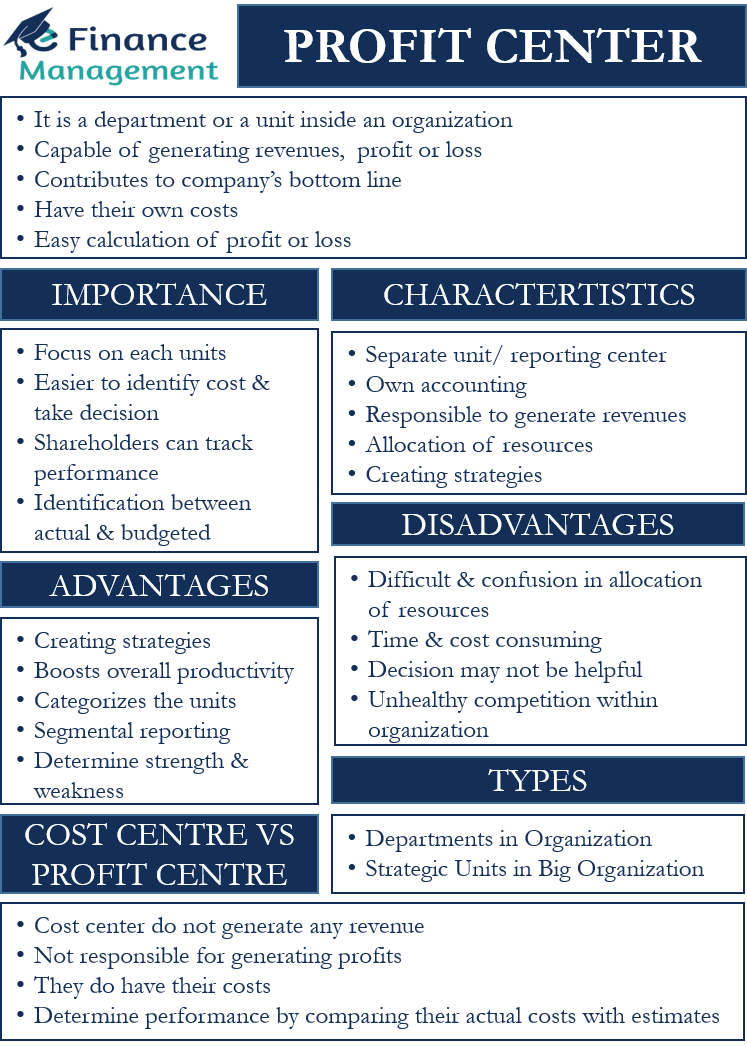
A profit center, on the other hand, is a business unit or division within an organization that generates revenue and is accountable for its profitability. Profit centers are typically responsible for selling products or services to external customers. Examples of profit centers include sales departments, retail stores, product lines, and business segments. Ultimately, cost and profit centers are essential in achieving organizational goals and objectives.
Authority of department heads
- They are often managed as separate entities within the organization, with their own profit and loss (P&L) statements.
- If the center has the potential to generate significant revenue, a profit center may be a better choice.
- Managers of profit centers are often empowered to make key decisions regarding product development, marketing, and sales strategies.
- Cost centers are responsible for managing and controlling expenses within an organization.
- Cost centers are accountable for managing costs and expenses within budget while providing necessary support and services to other departments.
This article looks at meaning of and differences between two different types of units of any business – cost center and profit center. Cost and profit centers are essential tools for organizations to achieve their goals. Align incentives for profit center managers and staff members with the organization’s overall financial goals. The allocation of resources may be adjusted over time as the needs of the organization change or new opportunities arise. But without the assistance of the cost centers, the profit centers won’t function well. Many start-ups may argue that there’s no need to keep cost centers within the organization since they incur many costs and don’t generate direct profits.
Do cost centers and profit centers have different performance measures?
Being head of a profit centre is usually more interesting and demanding than being just the head of a cost centre. The revenues could be sales to outside organisations or they could be internal sales to elsewhere in the organisation. For example, an IT department could be turned from a cost centre into a profit centre if it were to be allowed to charge IT users for the services supplied. Cost centers are any units or departments within a business that are responsible for incurring costs. For example, a maintenance department would qualify as a cost center because it spends money to maintain facilities and equipment rather than generating profit.
Conclusion – The Key Differences Between Cost Centers and Profit Centers

Large vertically integrated companies often have at least one upstream division that creates a product and a downstream division that distributes it or sells it to consumers. One design for such companies is to have a central upper management that decides what activities and activity levels should be provided by each division. With the output goals of each division established, each division will best contribute to the overall profitability of the corporation by trying to meet its output goals at minimum cost. Profit centers have the primary objective of maximizing revenue and profitability. They are evaluated based on their ability to generate sales, increase market share, and achieve profit targets. Profit centers have their own revenue streams, cost structures, and profit margins.
Real World Examples of Profit Centers
A revenue centre manager has control over the generation of revenue but not costs. Revenue centres frequently sell products from manufacturing sub-units and have no control of the costs incurred while manufacturing. Other performance measures used include growth in revenues and customer satisfaction. Examples of managers of revenue centres include the sales manager of a retail store, the sales department of a production facility, and the reservation department of an airline. Profit centers contribute to the financial success of organizations by focusing on revenue generation and profitability.
Any division of the organization that does not directly contribute to Net Profits but still generates costs while assisting key operations. Standard costing has been a foundational tool in cost accounting for decades, helping businesses set predetermined costs for products and measure variances against actual costs. So, even if the marketing department incurs costs and doesn’t generate direct profits, it enables the sales division to create direct profits for the company.
Another crucial metric is the return on investment (ROI), which assesses the profitability of the investments made by the profit center. ROI helps in understanding how well the profit center is utilizing its resources to generate returns. For example, if a profit splitting payments to reconcile expenses in xero center invests in a new marketing campaign, the ROI will reveal whether the campaign has successfully translated into increased sales and profits. This metric is particularly useful for making informed decisions about future investments and resource allocation.
For example, for a manufacturer of laptop computers, a cost unit would be a laptop. Similarly, a Supermarket chain like Big Bazaar or Walmart can identify their highly profitable stores by making a comparison of the profit made by each centre. The aim is to determine the cost of each operation regardless of the location within the unit.
In this article, we will explore the characteristics of cost centers and profit centers, highlighting their differences and similarities. While cost centers may indirectly contribute to revenue generation by supporting the activities of profit centers, their primary role is to provide support and services cost-effectively. Cost centers typically do not have the autonomy or authority to set prices or make strategic decisions that directly impact revenue generation. The primary objective of cost centers is to manage costs and expenses effectively to support the company’s overall operations. Cost centers are responsible for providing support and services to other departments within the organization, and their goal is to do so cost-effectively. Cost centers aim to minimize expenses and keep costs within budget while delivering the necessary support and services to other parts of the organization.
The resources allocated to cost centers are intended to support the provision of services and support to other parts of the organization cost-effectively. Cost centers are evaluated based on their ability to manage costs within budget while providing necessary support and services to other departments. Meanwhile, profit centers typically have a higher level of decision-making authority, as their primary objective is to generate revenue and profits for the company. Profit centers have the autonomy and authority to make strategic decisions, set prices, and manage costs to maximize revenue and profitability. The efficiency of cost centers is often measured by their ability to deliver high-quality services within budgetary constraints.
Hence, the subdivision of the factory into a number of departments becomes essential. Cost Centers function best in cooperation with other divisions and departments. Some cost centers like Human Resources work with every department of the company and support multiple processes. The larger the company, the more and better-integrated Cost Centers it will have.

